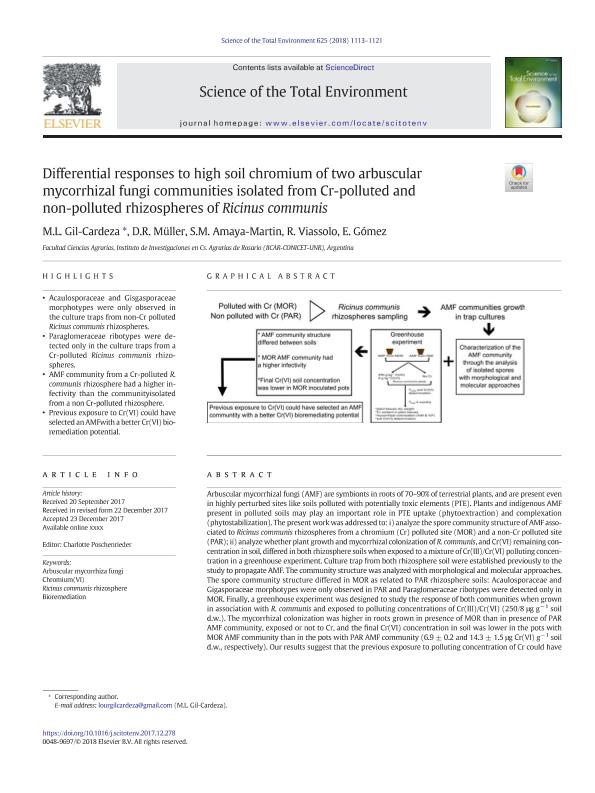Mostrar el registro sencillo del ítem
dc.contributor.author
Gil Cardeza, Maria Lourdes

dc.contributor.author
Müller, D. R.
dc.contributor.author
Amaya Martin, Shirley Margarita

dc.contributor.author
Viassolo, Rodrigo

dc.contributor.author
Gomez, Elena del Valle

dc.date.available
2019-11-28T22:24:07Z
dc.date.issued
2018-06
dc.identifier.citation
Gil Cardeza, Maria Lourdes; Müller, D. R.; Amaya Martin, Shirley Margarita; Viassolo, Rodrigo; Gomez, Elena del Valle; Differential responses to high soil chromium of two arbuscular mycorrhizal fungi communities isolated from Cr-polluted and non-polluted rhizospheres of Ricinus communis; Elsevier; Science of the Total Environment; 625; 6-2018; 1113-1121
dc.identifier.issn
0048-9697
dc.identifier.uri
http://hdl.handle.net/11336/90856
dc.description.abstract
Arbuscular mycorrhizal fungi (AMF) are symbionts in roots of 70–90% of terrestrial plants, and are present even in highly perturbed sites like soils polluted with potentially toxic elements (PTE). Plants and indigenous AMF present in polluted soils may play an important role in PTE uptake (phytoextraction) and complexation (phytostabilization). The present work was addressed to: i) analyze the spore community structure of AMF associated to Ricinus communis rhizospheres from a chromium (Cr) polluted site (MOR) and a non-Cr polluted site (PAR); ii) analyze whether plant growth and mycorrhizal colonization of R. communis, and Cr(VI) remaining concentration in soil, differed in both rhizosphere soils when exposed to a mixture of Cr(III)/Cr(VI) polluting concentration in a greenhouse experiment. Culture trap from both rhizosphere soil were established previously to the study to propagate AMF. The community structure was analyzed with morphological and molecular approaches. The spore community structure differed in MOR as related to PAR rhizosphere soils: Acaulosporaceae and Gigasporaceae morphotypes were only observed in PAR and Paraglomeraceae ribotypes were detected only in MOR. Finally, a greenhouse experiment was designed to study the response of both communities when grown in association with R. communis and exposed to polluting concentrations of Cr(III)/Cr(VI) (250/8 μg g− 1 soil d.w.). The mycorrhizal colonization was higher in roots grown in presence of MOR than in presence of PAR AMF community, exposed or not to Cr, and the final Cr(VI) concentration in soil was lower in the pots with MOR AMF community than in the pots with PAR AMF community (6.9 ± 0.2 and 14.3 ± 1.5 μg Cr(VI) g− 1 soil d.w., respectively). Our results suggest that the previous exposure to polluting concentration of Cr could have selected AMF species with a higher infectivity and thus more likely to better contribute to reduce the pollutant concentration in the soil.
dc.format
application/pdf
dc.language.iso
eng
dc.publisher
Elsevier

dc.rights
info:eu-repo/semantics/openAccess
dc.rights.uri
https://creativecommons.org/licenses/by-nc-nd/2.5/ar/
dc.subject
ARBUSCULAR MYCORRHIZA FUNGI
dc.subject
BIOREMEDIATION
dc.subject
CHROMIUM(VI)
dc.subject
RICINUS COMMUNIS RHIZOSPHERE
dc.subject.classification
Micología

dc.subject.classification
Ciencias Biológicas

dc.subject.classification
CIENCIAS NATURALES Y EXACTAS

dc.title
Differential responses to high soil chromium of two arbuscular mycorrhizal fungi communities isolated from Cr-polluted and non-polluted rhizospheres of Ricinus communis
dc.type
info:eu-repo/semantics/article
dc.type
info:ar-repo/semantics/artículo
dc.type
info:eu-repo/semantics/publishedVersion
dc.date.updated
2019-10-23T20:48:19Z
dc.journal.volume
625
dc.journal.pagination
1113-1121
dc.journal.pais
Países Bajos

dc.journal.ciudad
Amsterdam
dc.description.fil
Fil: Gil Cardeza, Maria Lourdes. Consejo Nacional de Investigaciones Científicas y Técnicas. Centro Científico Tecnológico Conicet - Rosario. Instituto de Investigaciones en Ciencias Agrarias de Rosario. Universidad Nacional de Rosario. Facultad de Ciencias Agrarias. Instituto de Investigaciones en Ciencias Agrarias de Rosario; Argentina
dc.description.fil
Fil: Müller, D. R.. Consejo Nacional de Investigaciones Científicas y Técnicas. Centro Científico Tecnológico Conicet - Rosario. Instituto de Investigaciones en Ciencias Agrarias de Rosario. Universidad Nacional de Rosario. Facultad de Ciencias Agrarias. Instituto de Investigaciones en Ciencias Agrarias de Rosario; Argentina
dc.description.fil
Fil: Amaya Martin, Shirley Margarita. Consejo Nacional de Investigaciones Científicas y Técnicas. Centro Científico Tecnológico Conicet - Rosario. Instituto de Investigaciones en Ciencias Agrarias de Rosario. Universidad Nacional de Rosario. Facultad de Ciencias Agrarias. Instituto de Investigaciones en Ciencias Agrarias de Rosario; Argentina
dc.description.fil
Fil: Viassolo, Rodrigo. Consejo Nacional de Investigaciones Científicas y Técnicas. Centro Científico Tecnológico Conicet - Rosario. Instituto de Investigaciones en Ciencias Agrarias de Rosario. Universidad Nacional de Rosario. Facultad de Ciencias Agrarias. Instituto de Investigaciones en Ciencias Agrarias de Rosario; Argentina
dc.description.fil
Fil: Gomez, Elena del Valle. Consejo Nacional de Investigaciones Científicas y Técnicas. Centro Científico Tecnológico Conicet - Rosario. Instituto de Investigaciones en Ciencias Agrarias de Rosario. Universidad Nacional de Rosario. Facultad de Ciencias Agrarias. Instituto de Investigaciones en Ciencias Agrarias de Rosario; Argentina
dc.journal.title
Science of the Total Environment

dc.relation.alternativeid
info:eu-repo/semantics/altIdentifier/doi/http://dx.doi.org/10.1016/j.scitotenv.2017.12.278
dc.relation.alternativeid
info:eu-repo/semantics/altIdentifier/url/https://www.sciencedirect.com/science/article/pii/S0048969717337117
Archivos asociados
